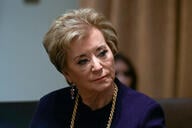You have /5 articles left.
Sign up for a free account or log in.
College and university presidents seem to be sharpening their knives for battle more than they’re falling on their swords these days.
This year has seen no shortage of public, controversial and often messy breakups between institutions and presidents who have dug in to try to keep their jobs. Ugly partings still represent a small minority of all changes at the top, but several experts have taken note of a recent glut.
Take, for example, the resignation this week of University of California, Davis, Chancellor Linda P. B. Katehi. She had been on administrative leave since April amid a steady drip of negative headlines including charges of nepotism and misuse of student fees. But when she resigned, her lawyer released a statement saying she had been “exonerated from baseless accusations,” even as a university system spokeswoman told the Los Angeles Times Katehi had “engaged in a pattern of misrepresentations” and “repeatedly exercised poor judgment when confronted with challenges.”
Katehi's resignation came shortly after Temple University President Neil D. Theobald reached an agreement to step down at the start of August. Temple's board had been preparing to fire Theobald after a multimillion-dollar financial-aid overrun became public and after he dismissed the university's provost, Hai-Lung Dai, in a highly controversial move this summer.
Suffolk University President Margaret McKenna was ousted at the end of July. Board members had criticized McKenna’s spending choices, and she faced allegations of verbally abusing employees. Reports pointed to tensions after Suffolk under McKenna terminated a contract with the public relations firm of George Regan, who had ties to trustees. Regan had alleged that McKenna loosely spent university money and verbally abused employees. McKenna's supporters had said she was being micromanaged, and Suffolk’s board chairman called the verbal abuse allegations “unsubstantiated.”
Yet trustees pushed out the president just months after the two sides struck a deal in February designed to keep her on until the start of the next academic year. McKenna said she was “disheartened by the violations of basic process.” McKenna said in a statement to The Boston Globe that she “fought a good fight against entrenched interests and a board that did not understand university governance.”
Each contentious firing or resignation this year has come under its own unique circumstances. But recruiters and those most familiar with higher education governance picked out several trends that are likely contributing to the uptick in messy separations. Broadly, colleges and universities find themselves under the uncomfortable glare of increased public scrutiny at a time when they are also struggling against heavy financial and enrollment pressures. Plus, relationships and expectations between boards and presidents have changed.
In that environment, the different sides aren’t always seeing eye to eye. When they don’t, conflicts are bubbling over in very public, very sensational ways. Given the trends, many expect to hear more and more about messy dismissals.
“I do think the publicity associated with it, as well as the messiness, is becoming a little more conspicuous,” said Richard Skinner, a senior consultant at Harris Search Associates who is a former senior vice president for programs and research at the Association of Governing Boards of Universities and Colleges. “I don’t see that stopping.”
Skinner has also been president and vice chancellor of Royal Roads University in British Columbia and president of Clayton State University in the Atlanta area, as well as an executive in the University System of Georgia. He listed several factors that could be leading to more bad breakups between universities and presidents.
There has been a push in recent years for boards of trustees to act more as custodians and focus on fiduciary oversight, Skinner said. More hands-on boards are naturally going to have more conflicts with presidents.
Presidents are also increasingly feeling that their jobs are in danger, Skinner said. That has many seeking legal protections in their contracts in order to secure their financial futures in the event they are fired. Skinner thinks the consequences can play out in the interactions between boards and presidents.
“You have, almost by default, created a more adversarial relationship,” Skinner said. “In an adversarial process, the board will ultimately prevail. You’ve almost planted the seeds for what will be a not-very-pleasant departure.”
Some disagreed with that idea, however. Raymond D. Cotton is a Washington-based lawyer who handles contract negotiations and represents boards and presidents alike. Boards understand contract negotiations are a business transaction, he said.
“A majority of boards -- and the majority is growing even larger -- are businesspeople,” Cotton said. “They’re big boys and girls, and they understand that part of the relationship between the president and the board is a business relationship. That is to say, the board is the employer and the president is the employee.”
Cotton spoke broadly about conditions in higher education but did not want to comment on any specific situations that may have involved his clients.
Many board members are corporate executives who have been through contract negotiations of their own with their employers’ boards of directors, Cotton said. But he added that boards have changed what they are looking for in a president. When Cotton started in the field in the early 1980s, boards were often looking for a Ph.D. with an Ivy League background in the liberal arts to become presidents, he said. Boards expected to be more focused on business issues and have the president focus on the academic side of the operation, he said. Although boards expected presidents to raise money, trustees were also willing to cut checks of their own or chip in with fund-raising if a president fell short of a goal.
“That has changed significantly to where we are today,” Cotton said. “They expect the No. 1 priority to be raising money.”
Failure to perform -- whether in fund-raising or other initiatives -- can lead to a quick ouster. Yet presidential firings haven’t always played out in public soap operas. Many described a time in the past when a board chair would take a president out to lunch, gently explain that the university needed to move in a different direction, and agree on terms that would have the president leaving quietly.
That’s a far cry from some of the infighting seen recently.
“I’ve been involved in many of these things,” Cotton said. “What happens is emotions take over. It gets down to, ‘I’m the boss. I’m the chairman of the board or the executive committee. This president, I’ve had enough.’”
Some have pointed to an influx of business ideas as driving messy breakups. But corporate breakups are often announced in brief press releases with little fanfare. It brings up the question of why the recent glut of ugliness has hit higher education.
One possible answer is that higher education is stressed as revenues are pinched, enrollments are constrained and the future of education is debated daily. That has emotions more likely to boil over.
“We’re seeing that a good number of institutions are, more so now than ever before, in financial difficulty or are considering options such as partnering with another institution, a buyout from another institution or closing their doors,” said Jamie Ferrare, managing principal of AGB Search, a Washington-based higher ed executive recruitment firm.
“All of that is to say I think the business model of higher education is under greater stress than ever before,” Ferrare said. “I think we’re seeing some of that reflected in boards’ frustration, saying, ‘We need someone to come in here and help us move in a different direction.’”
The window presidents have for arriving on campus and making changes has also grown shorter, Ferrare said. Instead of drawing up 10-year plans, presidents have two to five years to show results.
Still, shorter time spans don’t directly translate into presidents fighting openly for their jobs or spending months suspended while investigators draw up scathing reports on their conduct.
A divide sometimes exists between the expectations of presidents and boards, Ferrare said. Presidents are often holding on to job prospectus documents used in the search process. The prospectus typically lays out priorities that a new president will need to address. Presidents often see it as a starting point for their agendas, and it’s frequently scrutinized online by members of the public. But in the end, boards may end up with different priorities -- even after the hiring process is complete.
As a result, presidents can feel that the rules were changed in the middle of the game.
“I think what they’re doing is using that and saying, ‘You said this and this, that’s where I’m going and you changed your mind,’” Ferrare said. “I don’t know if everyone is taking that prospectus as seriously as some of the candidates are.”
Many of the messiest breakups seem to be happening at public institutions. Beyond UC Davis, the University of Louisville is a prime example. Longtime President James Ramsey resigned last month under an agreement brokered by Kentucky Governor Matt Bevin. Ramsey, who had been credited with major improvements in fund-raising, facilities and academic standards, had been hanging on to his position despite a steady series of recent controversies.
Even his departure was controversial, as he indicated he wanted to continue to work at the University of Louisville Foundation, where he is president. And he resigned to a new group of trustees after Bevin overhauled Louisville’s former board -- a move that has since been blocked by a judge and was still grinding through the legal process as of Thursday.
Public education is facing political pressures in many states, said Ronald Ehrenberg, the director of Cornell University’s Higher Education Research Institute.
“Governors now often have much more of a view of what they want their institutions to be, and they’re sort of loading boards with people who are close to them,” Ehrenberg said. “That makes things very, very difficult.”
Political dynamics can influence public institutions in other ways. In California, a system leader is likely uncomfortable asking the Legislature for more money if allegations of fiscal improprieties fly, said William G. Tierney, a professor of higher education and the codirector of the Pullias Center for Higher Education at the University of Southern California. That could have played into the ouster of Katehi at UC Davis. She faced intense scrutiny for decisions including spending on travel.
While it may seem like many of the worst breakups are at public institutions, private colleges and universities have had their fair share of bad situations. Kenneth Starr resigned as Baylor University's president and chancellor this year following allegations that the university mishandled sexual assault complaints, including against football players. Starr had initially been expected to remain chancellor. Simon Newman resigned as president of Mount St. Mary’s University after reports that he fired two faculty members and likened struggling students to bunnies that needed to be drowned.
Some see the balance of power at universities as having changed, putting more power in the hands of presidents and boards -- and inviting more scrutiny.
“The board exerts more control, which denotes the loss of faculty voice and decision making,” Tierney said. “But the board asserting more control has led to greater presidential power, often at the risk of making the sorts of mistakes that we’re talking about.”
Salary levels are another factor inviting presidential scrutiny, Tierney said. Presidents’ salaries have grown in recent years while other pay has been stagnant. And information -- whether on a president’s pay or on their alleged improprieties -- spreads more easily today than it has in the past. So even if controversial expense reports end up being legitimate, a situation’s optics can have lasting negative effects as it gets posted and reposted on Twitter and Facebook and hotly debated among community members, faculty and students.
“I think that information is so readily available, and so many people can comment on it, that it makes a big difference,” Tierney said. “There’s any number of activities that warrant applause, but it’s these acts of malfeasance that raise eyebrows.”
Tierney rejects the idea that overall presidential turnover has increased. Average presidential tenure has generally been between four and a half and seven years over the last quarter of a century, he said.
The average tenure of a university president in his or her current job at a doctorate-granting institution dropped from 7.6 years in 2006 to 6.2 years in 2011, according to the latest edition of the American College President from the American Council on Education. ACE is working on an updated report. But until it comes out, the latest statistics are five years old, meaning they could obscure more recent trends.
Regardless, any current spate of messy presidential separations has not yet approached the level of an epidemic, Tierney said. While they may seem more frequent this yet, he pointed out that messy breakups are nothing new -- and that they can drag on for years.
Former President Graham Spanier was ousted at Pennsylvania State University in 2011 in the midst of the sex-abuse scandal involving former football coach Jerry Sandusky. Just this year Spanier sued the university for breach of contract.
Messy breakups can have long-term effects on future executive recruiting and initiatives, said Lucy Leske, senior partner in the higher education practice at executive search firm Witt/Kieffer.
“If you’re trying to do a search in that environment, it can be pretty daunting for candidates,” Leske said. “If they go into an environment already highly charged with a gotcha culture and a group of people who are ready to pull the plug at the slightest mistake where there’s no forgiveness or room for conversation, then it’s hard to recruit leaders for those environments. It makes it harder for university leaders to act boldly.”




